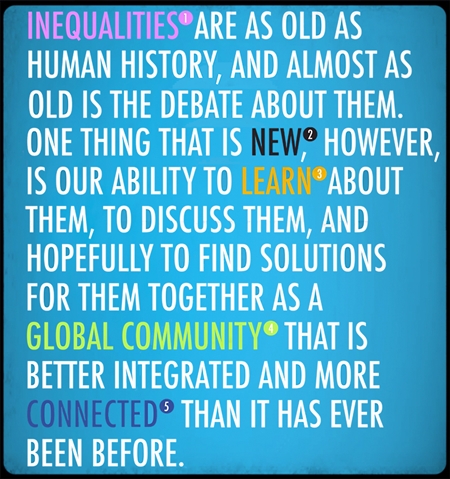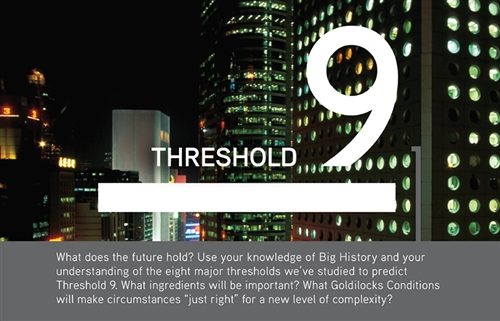Bridgette Byrd O’Connor, BHP Team Member
Louisiana, USA
In the words of the ‘90s band Blur, “And it looks like we might have made it / Yes it looks like we’ve made it to the end.” It’s certainly been a strange school year. For some, it might be a more welcoming or disheartening sight than usual, considering the upheaval of the COVID-19 pandemic. For this blog post, we’re going to do something different and transform our Big Questions blog into a series of posts that tie together the BHP and WHP courses. If you’re unfamiliar with the Big Questions blog, it’s a series of posts written to provide teachers with tips on how to use BHP content to answer the driving question for each unit of the course. Our goal in doing this is to highlight how we can look to our past to inform our present and prepare us for the future.
The driving question for BHP Unit 10 (“What’s the next threshold?”) and the course objectives for WHP fit together nicely. When reflecting on the next threshold and what makes history usable, students can begin to understand how historians think about crises such as the COVID-19 pandemic and how they make sense of these events from a historical perspective. While this moment in history is unlike any other, there’s also a lot that history can teach us about what’s happening in the world today.
For example, I’m sure you’ve read a number of comparisons between the COVID-19 pandemic and previous ones, especially the 1918-1919 influenza pandemic. These types of comparisons can help students come to terms with what’s happening in their lives, show them how much we have discovered from previous pandemics, and also teach them how much we have left to learn. More importantly, studying something that has touched everyone in one way or another and comparing that with events in the past allows students to see what makes history usable, probably in a way that they’ve never experienced before.
So what’s next? How will this pandemic change our communities? These questions can be difficult to answer. In the short-term, we’ll probably all continue washing our hands a bit more than we used to do and practicing some form of social distancing—avoiding handshakes and keeping a bit more space between ourselves and others. There may also be some cultural shifts in terms of the value we place on certain jobs such as healthcare workers, hourly wage employees at grocery stores and pharmacies, and postal workers. In essence, all of those who are going to work every day to make sure we still have the health care, food, and supplies we need during this crisis. This newfound respect for front-line workers will hopefully lead to legislative and economic changes such as an increase in minimum wage. In terms of changes to our networks or how we share goods and information, a lot of us are using some form of distance learning and online meetings. The fact that we know that some sectors of society can be productive from home might change how we work, especially as we continue to social distance in the near, to maybe more distant, future.
There are a number of assets that can be used in your distance learning classroom to help students make their own predictions about our post-COVID 19 world. If you and your BHP students haven’t already used COVID-19 for a What Do You Know? What Do You Ask? activity, this would be a great time to ask them to formulate the best team to try to prevent a future pandemic from shutting down the entire world. This topic could also easily work for the BHP Visions of the Future activity in Lesson 10.1 and the follow-up activity in Lesson 10.2—The Future of Our Planet. In the Crash Course World History video (found on both the BHP and WHP sites) Globalization II: Good or Bad, John Green discusses a range of topics including the 1918 influenza pandemic and the possibility of a future pandemic. He also examines how globalization might create the perfect conditions for a virus to spread quickly (think travel—airplanes and cruise ships). But he ends the video on a high note, emphasizing how we can work together to solve the challenges of globalization. Green concludes that “Every human is a historical force”—a call to action for students living in an uncertain time. Thinking in this way will help students see that history can be used to make positive changes in our global community. For WHP students, there are activities like UN Sustainable Development Goals (in the Origins course) and The World in 2050 (in the 1750 course) that will help drive home this point and get them to think about what’s to come and how they can help create change in the world.
 Detail from Globalization II - Good or Bad?: Crash Course World History #42
Detail from Globalization II - Good or Bad?: Crash Course World History #42
Ending with activities that push students to think about how they can help, not just in this time of crisis but in the long-term future, may provide that little glimmer of hope that we all need right now.
About the author: Bridgette Byrd O’Connor holds a DPhil in history from the University of Oxford and has taught the Big History Project and World History Project courses, and AP US government and politics for the past 10 years at the high school level. She currently writes articles and activities for WHP and BHP. In addition, she has been a freelance writer and editor for the Crash Course World History and US History curricula.
Cover image: From left to right:
- Postal worker in Central Florida, photo by Mick Haupt on Unsplash, public domain.
- Cancer researcher at the National Cancer Institute's Experimental Immunology Branch working in a lab.Photo by National Cancer Institute on Unsplash, public domain.
- Cashier at Wal Mart - Plateros store located in Mexico City. Photo by Enriquecornejo, public domain.
- Farmer in a field, Brownsville, US, photo by Gregory Hayes on Unsplash, public domain.
- Subway message for commuters, New York City, photo by Daniel Lee on Unsplash, public domain.
- Delivery driver, photo by Victória Kubiaki on Unsplash, public domain.
- English NHS nurse staff in personal protection equipment (PPE). Photo by Luke Jones on Unsplash, public domain.
- Chef preparing dumplings, photo by Craig Whitehead on Unsplash, public domain.
- Grocery story worker, photo by Nielson Caetano-Salmeron on Unsplash, public domain.
 For full access to all OER Project resources AND our amazing teacher community,
For full access to all OER Project resources AND our amazing teacher community, 

